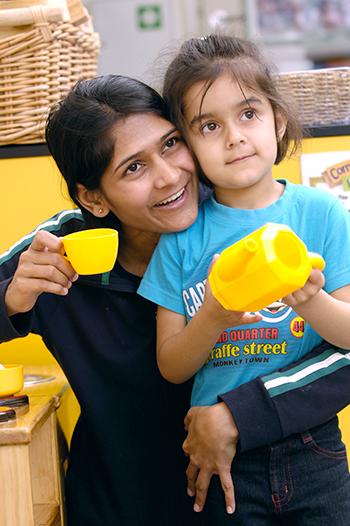Pouring a drink
Duration/age

Talk about how thirsty your child is - do they want a big glass or a small glass? Is there a favourite glass that they have and can they find where it is? Will they have a hot or a cold drink and where would they find the drink? When you pour the drink will it be from a tap that may come out of the tap very fast or will it be poured from a jug slowly?
Compare different sized glasses to see if they hold the same amount of liquid or if one holds more than another. You can talk about how full to make the drink and whether there will be a little bit poured into the glass or if it will be filled up to the top.
Materials you will need
- Glasses / cups
- Measuring jugs
- Paper cup
- Teacup
Alternative tools
- Paper cup
Skills this activity improves
Why does this matter?
Pouring a drink helps children to begin to explore size and the capacity of different objects. As you pour liquid into differently sized glasses children are able to compare both the volume and the capacity of the containers.
What does this lead to?
Pouring a drink helps children to understand that there are different ways we can measure and compare things. We can compare them by number, size, shape, volume, temperature or speed.
Language to use
- Stop, start, slowly, quickly, longest, fastest
- Top, bottom, near, far, off, on
- Full, empty, more, less, enough, too much, too little
- Edge, middle, front, back
- Wide, narrow
Questions to use
- How thirsty are you?
- What size glass do you want?
- What would happen if you didn’t stop pouring when the liquid reaches the top?
- Why do you need to move the glass away from the edge?
- Which glass is bigger?
- Which glass will hold more?
- Do you want more to drink?
Useful tips
- Have differently sized glasses as this will help when talking about capacity of a glass.
- Use jugs for pouring that are different sizes and widths as this will also enable children to compare size and volume.
- Use jugs with measurements on the side. This will help children to notice that numbers help us to measure and identify size and volume.
- Remember to talk to your child in your home language.
More ideas
- Set up a sand / pouring tray with differently sized containers for filling and emptying.
- Add measuring jugs and containers to the bath at bath time. Talk about the numbers on the side of the jug and what they are used for.
- Collect plastic tubing and use it to pour from one container to the next. Does it make a difference to how fast the liquid moves down the tube if the tube is wider or narrower?
- Make your own egg timers with sand to time how long things take. Create timers that are different sizes and shapes to see which one empties fastest and which takes the longest.
Variation by age
Birth to two year olds
- Set up a sand / pouring tray with differently sized containers for filling and emptying .
- Add measuring jugs and containers to the bath at bath time. Talk about the numbers on the side of the jug and what they are used for.
- Collect plastic tubing and use it to pour from one container to the next. Does it make a difference to how fast the liquid moves down the tube if the tube is wider or narrower?
- Read the story of “Who Sank the Boat?” by Pamela Allen.
Three to five year olds
- Collect plastic tubing and use it to pour from one container to the next. Does it make a difference to how fast the liquid moves down the tube if the tube is wider or narrower?
- Make your own egg timers with sand to time how long things take. Create timers that are different sizes and shapes to see which one empties fastest and which takes the longest.
- Set up differently sized and shaped containers outside to collect rain. Record how much rain has been collected in each container and compare the volume collected to the size of the container.
- Read the story of “Mr. Archimedes’ Bath” by Pamela Allen.
Questions to ask
- Which has more?
- Which has less?
- Do the numbers go up?
- Which is full?
- Which is empty?
- Which is the fastest?
- Which is the slowest?
Questions to ask
- Which has more?
- Which has less?
- Do the numbers go up?
- Which is full?
- Which is empty?
- Which is the fastest?
- Which is the slowest?
- Which is the heaviest?
- Are they the same or different?


